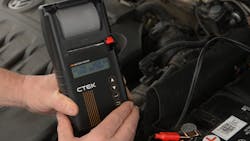
At the heart of every vehicle lies the battery, a crucial component that powers many functions – from starting the vehicle, to running its headlights, to keeping the heat going during the chilly, winter months.
“The modern battery can never sleep; the demand for energy from over 200 on-board computers is 24/7,” says Tony Zeal, CTEK Skillbase training manager. “The battery has become so essential it even has its own management system to look after it.”
Regardless of the battery’s management system, routine check-ins and maintenance are still necessary to keep the battery in optimal performance condition. To achieve this, technicians not only need the appropriate certifications but the correct tools and equipment as well. With all the developments in progress for vehicle batteries, having the right tools on hand is more important than ever for technicians.
Up and coming
For the longest time, vehicle batteries were mostly all the same type – a wet sealed lead acid 12V battery. But the industry is changing, and new technology, like the absorbed glass mat (AGM) battery, enhanced flooded batteries (EFB), also known as start-stop batteries, and lithium-ion batteries have emerged. With this new technology comes new requirements for how the batteries must be charged and tested.
“You no longer can use your daddy's battery charger that you inherited 25 years ago,” says Gary Mackey, vice president of global sales and marketing for Associated Equipment. “You must have a battery charger that is designed to be used with each of the new technology battery types.”
Along with the new battery types, there has been a shift in charging voltages. Batteries are now being charged at slightly lower voltages than before to protect them from overcharging. Technicians must be careful to charge batteries on the correct setting (AGM, EFB, Lithium) and at the proper voltage otherwise they risk shortening the life of the battery or damaging it beyond repair.
Other changes technicians will be seeing in the modern vehicle are most vehicles now have at least two batteries in them, and very few batteries are located under the hood anymore. Most batteries are now mounted under the front seat, under the back seat, or in the trunk, Mackey notes.
These changes come from the industry working towards meeting the Environmental Protection Agency (EPA) and the California Air Resources Board’s (CARB) standards for corporate average fuel economy (CAFE).
As vehicle manufacturers work to meet those goals, changes as the dual battery vehicles are coming into play. In these vehicles, one battery is a start-stop battery, and the other is the auxiliary battery.
“When you pull up to the [stoplight], the car automatically turns itself off, and when you take your foot off the brake, again, it automatically restarts,” Mackey explains. “But that two minutes … when you're not running the start-stop battery, [the] auxiliary battery runs everything in the car for you. It runs the lights and the heat and everything so that you're not killing your regular battery.”
In the next two or three years, Mackey believes it is likely that a person will not be able to buy a vehicle without a start-stop system in it, as they will be driven to meet those fuel economy guidelines.
The tools for the job
For every job or repair a technician works on, they have a specific set of tools. Battery maintenance is no different, and with all the changes to batteries over the years, it is essential that technicians update their tools along with the technology. To properly maintain a vehicle’s battery, a technician needs a good battery charger, a battery registration device, a digital battery tester, a terminal cleaner, a multimeter, and special insulated tools and equipment for any hybrid or electric vehicle battery work.
Battery charger
Battery chargers are a prime example of equipment that shops may need to update. A technician can no longer just throw a charger on a battery and call it good. They must have a charger that can adapt to whatever battery they are charging and be able to change the charging voltage when necessary.
When a technician is charging the battery on a Mercedes, for example, if the technician uses the wrong kind of battery charger, the battery can be damaged in less than an hour. This damage could then result in spending $600-800 to replace the battery, Mackey says.
Technicians must know what kind of battery they’re trying to charge as well as its charging voltage before hooking it up to the battery charger. Mackey cautions that finding this information has become a bit more complicated with some batteries now being remotely located within a vehicle as opposed to under the hood. He suggests seeking out the manual to find the information.
Mackey also notes that, when it comes to selling battery chargers, shops may argue that they work on “older cars,” so they don’t need a charger that handles this new battery technology. AGM batteries have been in cars as far back as 1999 and in cars like the Toyota Prius, the Chevrolet Corvette, and almost all European cars from about 2007 to now.
“If you’re working on cars that are as far back as 1999, which is a 21-year-old car today, you have a chance of seeing these new technology batteries,” Mackey says.
Battery registration device
The battery registration device is another example of a tool needed to work on the new battery technologies. A lot of vehicles now have an electrical system known as a smart charging system. Essentially, when the battery does not require a charge, the alternator is not engaged. This means there is no draw on the engine, which helps with the vehicle’s fuel economy, Mackey explains.
However, if a technician replaces a battery in a vehicle with a smart charging system, they must “tell” the vehicle the battery has been replaced, otherwise the vehicle will continue functioning as though the old battery is still inside it and cause premature damage to the new battery.
Using a battery registration device can prevent this. The device works similarly to a scan tool, where a technician just hooks it up to the vehicle’s diagnostic connector. Then, the technician chooses the type of vehicle and selects the battery reset. From there, the technician is asked some basic questions about what kind of battery was placed in the vehicle to ensure it was the correct battery type. Once the technician has gone through this process, the device will update the smart charging system, and the system will automatically relearn the charging system that it will not damage the new battery, Mackey says.
Though this process is not necessary on all vehicles, many do require it, and the last thing a shop wants is a customer returning upset that their battery is acting up when it’s just been replaced because the smart charging system wasn’t updated.
Digital battery tester/Carbon pile loader
Digital battery testers and carbon pile loaders kind of go hand-in-hand because the carbon pile loader was the original battery tester before things went digital.
Though many technicians prefer the digital battery tester, there is still a percentage of them out there who would rather use their carbon pile loader to test a battery.
Jim O’Hara, vice president of marketing for Clore Automotive, discusses the dawning of the digital battery tester: “When we launched our digital testers in 2008 we said, ‘Throw all the rest of them away.’ We discontinued everything but our old, what is affectionately referred to as a “cheese grater” … our old [load tester]. We got rid of everything else, and what we found was, well, maybe we had jumped on the bandwagon a little too hard…so by 2012, we introduced three new traditional load testers.”
The biggest difference between a digital battery tester and a load tester is that when using a load tester the battery being tested must be above an 85 percent state of charge, O’Hara explains. If it’s not, then the technician isn’t going to get an accurate result. The question then becomes, does the technician take the time to charge up the battery and then test it, potentially wasting their time on a battery that’s no good anyway? Especially when a digital tester takes a matter of seconds to test a battery.
Additionally, “The speed and convenience of a digital tester is central to the idea of testing [vehicle batteries] every day,” O’Hara says. If a shop tests every battery that comes in not only does it give customers peace of mind, but also provides the potential for extra revenue for the shop with battery replacements and other repairs.
Hybrid and electric vehicle tools and equipment
In addition to the tools mentioned above, when a technician is working on a hybrid or electric vehicle, they need a special set of insulated tools. The tools should be insulated up to 1,000V. This will help keep the technicians safe from the high voltage batteries in these vehicles.
Aside from having insulated screwdrivers, wrenches, etc. technicians should also have a pair of insulated gloves and barriers to mark off the high voltage working area, CTEK’s Zeal says.
A technician needs not only this specialized equipment, but also special training to work on these vehicles.
“Unless you are trained, do not work on electric vehicle [or hybrid vehicle] systems. It can kill.” Zeal warns.
Additional tools
Zeal also recommends having a battery terminal cleaner and a multimeter – voltage and amperage, AC and DC – for working on any vehicles’ battery systems.
Selling tips
1. Be familiar with the tools.
O’Hara suggests honing in on a specific digital tester or battery charger and using it “a lot” for a week or two to get a good understanding of the features and benefits the tool has to offer. Then, the tool can be used for demo purpose, as well as for loaning to any interested shops or shops for a one-week trial run.
2. Show them the money.
When trying to make the sale, Zeal suggests using a cost calculator tool to show the shop or technician how quickly the equipment will pay for itself, and then, be making them money.
3. Identify their needs.
It’s easy for customers to get caught up on the price of a product. To counteract this, Mackey recommends pulling the customers attention not toward the price, but toward what they need to run a successful and profitable shop.
Most importantly though, when selling tools, always look ahead. Over the next few years battery technology is going to continue to change, so sell tools that not only meet a customer’s present needs but will meet their future needs as well.
About the Author
Emily Markham
Editor | PTEN and Professional Distributor
Emily Markham is the editor of Professional Tool & Equipment News (PTEN) and Professional Distributor magazines. She has been writing about the automotive aftermarket since 2019, after graduating from UW-La Crosse with a bachelor's degree in English. During her first three years with EndeavorB2B's Vehicle Service & Repair Group, Markham also wrote for Fleet Maintenance magazine.
Don't miss Markham's next article. Sign up for PTEN or Professional Distributor's weekly newsletter.
